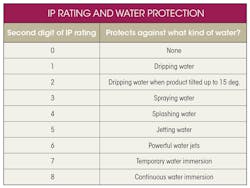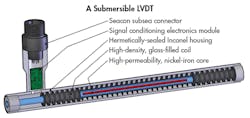LVDTs, or linear variable differential transformers, are electromechanical transducers that convert an object’s rectilinear motion into a corresponding electrical signal, thus measuring distance traveled or position. They can measure movements as small as a few millionths of an inch up to several inches, but can also measure positions up to ±20 inches (±0.5 m).
Most LDVT components are protected against the environment to some degree. But there are applications where more protection is needed, especially against water. To help engineers and companies know how well a specific component is protected against the environment, the International Electrotechnical Commission (IEC) established Ingress Protection Ratings, known as the IP system (as per IEC’s EN 60529).
IP ratings classify how well a device is protected against infiltration by foreign materials such as dust and water. The IP rating’s first digit indicates the protection level against solids (dust, dirt, and debris) entering a sensor, while the second one notes moisture resistance. A zero indicates no protection at all, and higher numbers identify more stringent defense against the elements.
LVDTs typically carry IP ratings between IP-61 and IP-68. They all keep out dust and dirt in almost every configuration, hence the constant use of the number “6” as the IP rating’s first digit. But LVDTs have different levels of water ingress protection based on their construction.
For example, some LVDTs are built with limited coil protection against liquids, while others are protected with varnish or epoxies. Hermetically-sealed LVDTs are welded closed so nothing can get inside the sensor. Each type of LVDT construction bears a different IP rating and may vary by manufacturer. Below are IP ratings for LVDTs offered by TE Connectivity.
Non-Hermetically Sealed LVDTs(IP 61)
The external sealing of non-hermetically sealed LVDTs meets IEC standard IP-61. As these sensors are protected from dust ingress and condensation, they are suitable for the following applications:
- Dry environments with limited dust/dirt exposure
- Laboratory testing, indoor applications
These applications include precision gaging, dials and indicators, and position feedback for robotic actuators.
When coils are completely encapsulated in epoxy, non-hermetically sealed LVDTs increase their rating to IP-64, making them suitable for use in environments where heavy humidity is possible.
Hermetically-Sealed LVDTs (IP 68)
Hermetically-sealed LVDTs are constructed entirely of stainless steel and incorporate coil windings sealed against hostile environments, earning them a rating of IP-68. In addition to being protected from dust and dirt, they are tested to confirm they keep out water despite long-term immersion in water up to a specified depth. They are suitable for the following applications:
- Monitoring outdoor structures
- Valve positioning
- Heavy industrial tasks
- Sensing applications in environments with dust, dirt, grease, and humidity.
Sensors that carry IP 68 ratings must also exceed IP-67 ratings. LVDTs with an IP rating of 68 are sealed via welding; all wetted parts are constructed of metal, except the connector. The LVDTs themselves can be submerged in water or other fluids exerting up to 1,000 psi when not operating. When the sensor is expected to be temporarily submerged during operation, more protection should be added to the mating plug.
Submersible LVDTs (IP 68)
Submersible LVDTs with a Seacon-Branter mating connector are rated at IP 68. The connector and mating plug are rated for pressures to 5,000 psi or higher. These LVDTs are typically designed with a 20-year life for use in critical applications where access to the unit for replacement or repair is costly. They are recommended for applications involving immersion in fresh or salt water—among them, monitoring mooring cables, dams, and bridge structures; monitoring underwater oils and gas valves and devices; and providing position feedback on unmanned submersible vehicles.
Mike Marciante, Applications Engineer
TE Connectivity, Pennsauken, NJ
Looking for parts? Go to SourceESB.


